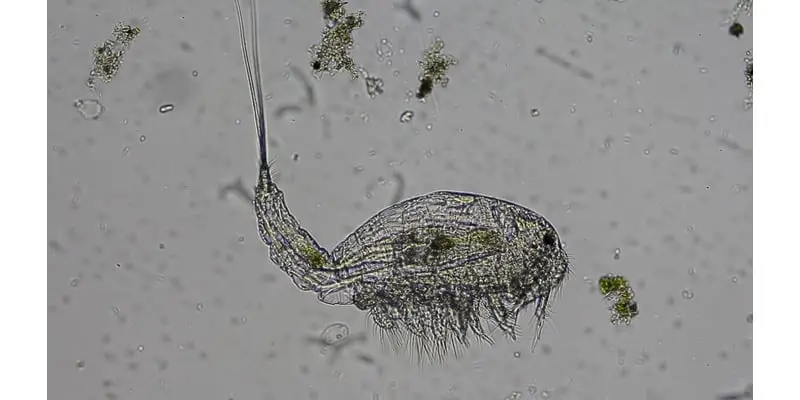Planet Earth is home to an overwhelming number of living organisms. Some of them are large enough for us to see, like fish, animals, and other human beings, while others are far too small to notice with the naked eye. Although larger copepods can be seen with the naked, to see the rich detail and structure of this interesting creature they are best observed under a microscope!
Copepods, also known as the locusts of the sea, are water-borne crustaceans found both in fresh water and water with high salinity. Copepods typically measure from 1 to 2 millimeters in length and can be symbiotic or parasitic. First discovered in 1840, there are over 4,500 species of copepods and most of them enjoy eating phytoplankton, making them a desirable addition to aquariums of all sizes.
In this article we will review the structure and anatomy of copepods as well as their behavior and biological functions. If you happen to have a place where you can catch some copepods yourself, I will also explain how you can observe these alien looking creatures under a microscope.
Copepod Overview
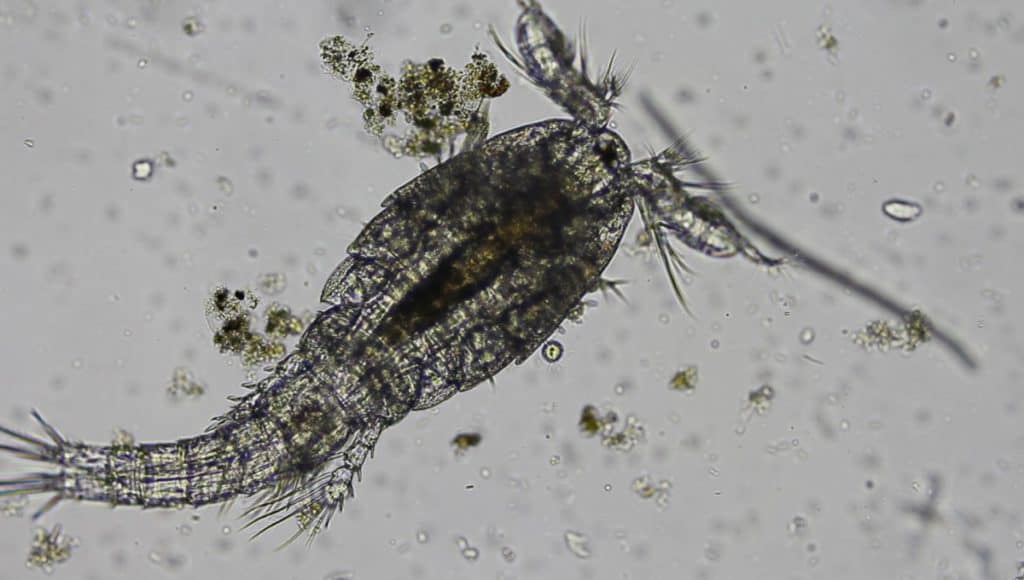
These microorganisms don’t need too much water to survive in fact they’re small enough to fit inside a large water droplet! You can spot them (with a microscope, of course) in many salt and fresh water bodies including the pond in your neighborhood. They can even be found in the deep, dark trenches of the ocean!
There are many different types of copepods. Copepods may be free-living, symbiotic, or parasitic (either internal or external). Adult copepods have a full size of around 1-2 millimeters. Their maximum adult size is 1-2 mm but you can find many mature copepods that are 0.2 mm long. Some copepod types are excused from this rule, though. Exceptions include free-living copepods that might reach 17 mm (1.7 cm) and parasitic variants that can grow up to an astounding 20 centimeters!
Planktonic copepods are another class of this organism. They are generally on the shorter end of the size spectrum and play an important role in many natural food-chains. Their primary focus is the aquatic food web, where you can see them feed off microscopic algal cells of phytoplankton. In turn, they are consumed by young fish and other marine life that enjoy planktivores, including some whales.
Copepods are sometimes used as biodiversity indicators, too, due to their placement in the food web and interlinkages they enable between different living beings within the same environment. To learn more about energy flow check out this post.
When placed inside freshwater, particularly stagnant forms, copepods may behave like a biological control mechanism to halt the spread of malaria. Malaria is a life-threatening disease and is particularly rampant in parts of Africa and Southeast Asia. There is no stable, reliable vaccine for it, which is why scientists try and combat malaria colonies from forming with the help of copepods, which feed off mosquito larvae, all of which are potential carriers of the malarial parasite. On the downside, some variants of copepods can serve as intermediate hosts to several animal parasites and even some human parasites, including fish tapeworm and guinea worm.
How Are Copepods Classified?
Copepods have a unique place within biological taxonomy. Their taxonomical class is “maxillopoda” under the species “Arthropoda,” consisting of a wide variety of small animals, most of which pass as crustaceans. Sometimes, scientists choose to classify them alongside barnacles due to their similar behavior and anatomy.
Depending on where they dwell, you can classify copepods as either planktonic or benthic. Planktonic copepods can be found drifting within seawater, particularly in the top layer. Benthic copepods, on the other hand, live on the ocean floor. Apart from these two primary branches, some species of copepods have parasitic phases that live within other living organisms and use them as a source of food.
In contrast to this, you will find some continental species that live in limmnoterrestrial habitats and any place that’s damp enough to foster organic growth. There are over 4,500 species (variants) of copepods. Each one serves a different purpose, bearing a unique size and flaunting its own mode of nutrition.
What Do Copepods Eat?
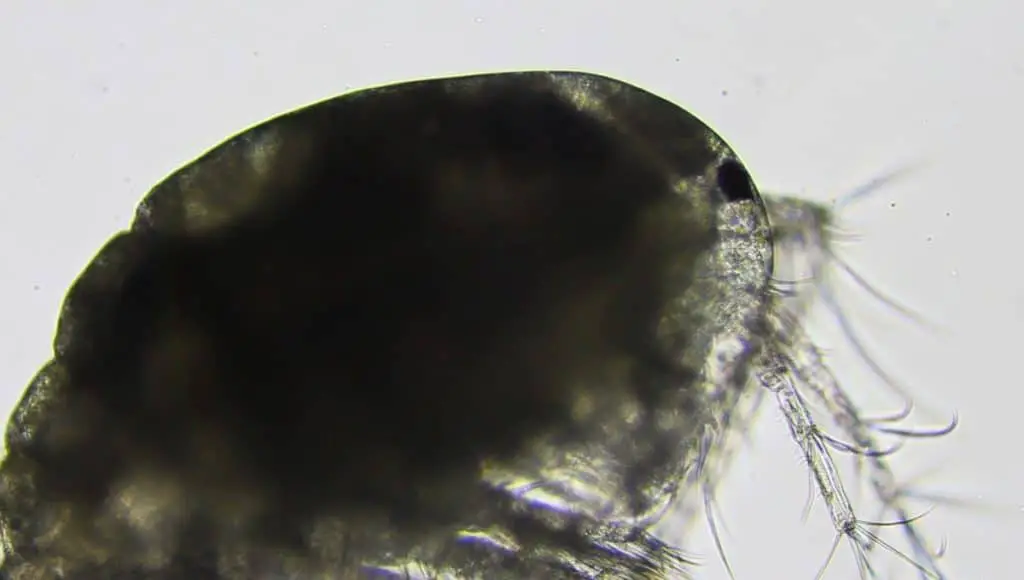
It is important to understand that different types of copepods have different modes of nutrition. Their diet heavily varies too, depending on the copepod variant you’re dealing with. While some prefer to feed off mosquito larvae, others might prefer algae.
Most free-living varieties of copepods can be found feasting directly on phytoplankton, which is why they’re classified as “planktonic” copepods. These organisms may be small, but their appetite is overwhelmingly large. A single copepod can chomp down on 370,000 phytoplankton each day! In order to achieve this astounding goal, planktonic copepods have to go through a million times their internal body volume to cover their daily nutritional needs. Once the goal is met, a new day begins, and they start this routine all over again.
Copepods may be ridiculously tiny, but they don’t mind a bit of natural cannibalism. Larger species can sometimes be seen devouring their smaller counterparts (generally those from a different copepod species, but a copepod nonetheless!) with no shame. As long as these crustaceans are meeting their daily diet goals, they will feast on whatever seems suitable in the moment.
Not all copepods are carnivorous, though! You will find plenty of herbivorous species, too. That’s right-vegan crustaceans!
You will find these fascinating creatures in the cold, dark depths of the sea. They store their energy in the form of oil droplets within their bodies. In the spring and summertime, they feed off plankton blooms. In polar varieties of copepods, these oil droplets, or food reservoirs, makeup over half the interior volume of a copepod’s body.
Parasitic copepods live off their host organism. Parasites are those organisms that only take from the hosts without giving anything back. 30% of all copepods out there (3 of the 10 known copepods orders) are parasitic. Most benthic copepods live off organic detritus or the bacteria growing within it. Their mouths have adapted to scrape and bite at their food, making it easier to consume such things.
As for the eating mechanism, the copepod will use their remarkable mouth to guzzle down its food. What sets a copepod mouth apart from other crustaceans is the presence of unique filter combs at the mouth opening. This somewhat resembles the filter bristles found inside a whale’s mouth, which is not surprising since both copepods and whales live within the sea and feed off similar foods. This particular mouth helps the copepod sift between particles that qualify as food and those that do not.
Interestingly, copepods may sometimes accidentally consume toxic algae. When this happens, the copepods begin to act in a random, sporadic manner. Their behavior after consumption of this toxic algae has been compared to being “drunk.” Toxic algae can intoxicate copepods but, unfortunately, cannot be filtered out by their mouth’s filter combs. Intoxicated copepods often end up dead very soon. They find it harder to dodge predators and often end up as prey. However, as long as they stay away from such troublesome algae, these microorganisms should be okay and die out after their regular lifespan has ended!
What is the Structure and Anatomy of a Copepod?
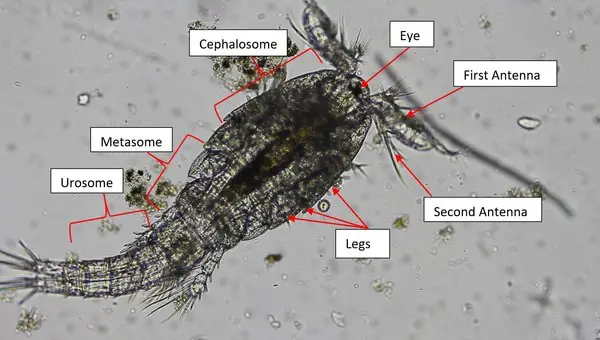
Copepods have remarkably interesting anatomy. While it’s based on the general crustacean structure, there are some notable differences within the anatomy that make it unique and identifiable as a copepod.
The calanoid copepod is one of the simplest forms of this crustacean. These copepods have bodies that are divided into three segments:
- Cephalosome
- Metasoma
- Urosome.
Together, the cephalosome and metasoma form the prosome, essentially the entire copepod body except for the tail section.
Free-swimming copepods use their five pairs of swimming legs to make their way through the water. These legs are attached to the metasoma and are found in the middle of the copepod body. Without these legs, copepods would be stuck in one place and have to surrender to the water’s wave motion to be carried anywhere. Luckily, though, with feet, they can move in whichever direction they want. This helps them catch whatever they’re preying on, whether it’s plankton or another copepod.
The name “copepod” can directly be translated to Latin to mean “oar feet.” This suggests that these 5 swimming leg pairs are somewhat oar shaped and have a similar mode of movement.
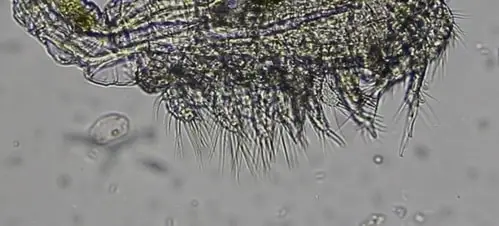
Copepods have a tough exoskeleton, which is typical of crustaceans. This protects them from predators and the tough waves in the sea, as well as other natural threats. They also have joint appendages, which makes it easy for them to move the body. The appendages give them flexibility, and they can move like a fish.
Some species have a single simple eye in the middle of the head. Sometimes, these eyes stay for longer, but they disappear after the larval stage in most cases. There are no compound eyes to be found on this crustacean in any case!
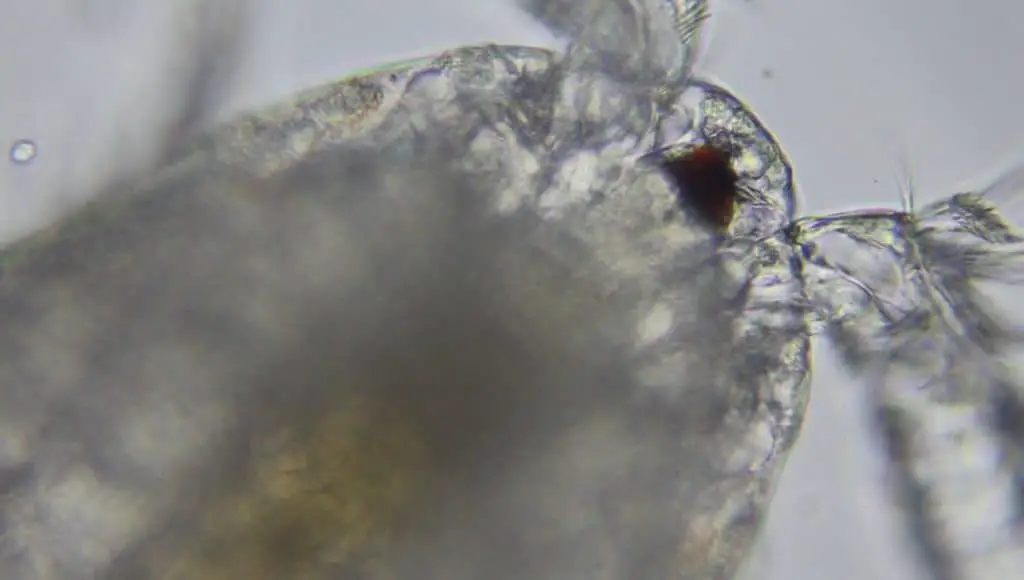
If the eye is present, it can only differentiate between darkness and light. It cannot show the copepod where to go next or what’s in front of them in high definition. The eye serves as a guiding point rather than an actual eye, but this is a typical feature of microorganisms.
There are also two pairs of antennae. One pair is longer, while the other is short. The antennae is thought to have some sensory aspects to it but its primary function is for acceleration when the copepod “hops” through the water.
Females have additional egg sacs attached to their abdomens to aid in reproduction. Usually, there are only one or two egg sacs. When talking about the urosome, or tail end, of the copepod, you’ll find a genital segment (for reproduction), an anal segment (for excretion), and a caudal ramus. There is also a “fural rami,” which is at the very tip of the tail and resembles a mermaid looking tail end.

Where Do Copepods Live?
Copepods can be found in all kinds of wet habitats both fresh and saltwater. Freshwater species can be spotted dwelling in the riverbed, lakes, ponds, and freshwater springs.
Sometimes, you might even spot copepods in damp moss patches or wet leaf bundles on the forest floor. These crustaceans multiply remarkably fast, too, which means that they have no trouble spreading all over the place!
“Domestic” copepods sometimes end up in aquariums, though this is rare. They’re more or less transparent but often have a reddish or beige-colored tint to them. Remember, though, that you’ll only be able to spot a copepod this way if it’s large enough; only a few copepod species have adults that are big enough to be seen with a naked eye.
How to Observe Copepods Under a Microscope?
Typical adult copepods range between 1-5 mm in length. That’s why to study their biological characteristics and internal structures researchers will need a compound light microscope. Higher quality microscopes cost more and will let you get a better look at the copepods. However, using the proper techniques, copepods are viewable with even cheap microscopes.
However you don’t necessarily even need to use a compound microscope. I used this digital microscope to get the image below because they are a little bit larger that the normal microorganism I observe. This is a really cool way to observe copepods if you don’t have a compound microscope or don’t want to spend the money.
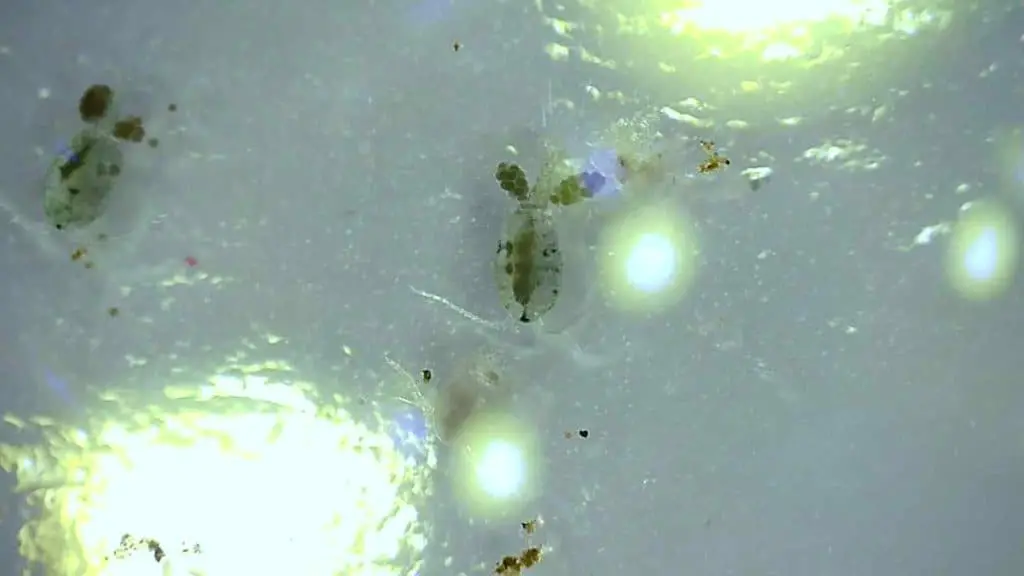
To observe copepods under a compound microscope, take your pipette and suck in a small amount of water from your copepod sample and place a small droplet on the slide. You should be able to see a few copepods because typically they are large enough to be seen with the naked eye. Use the tweezers to slowly lower the slide coverslip down over the droplet. For more detailed information on how to prepare a wet mount see this post.
You may also find that there is not enough movement when you have a slide coverslip. The copepods are big enough that they will not be able to move around properly so it may be better to observe them without a slide coverslip. However, if you do this make sure you are aware of how close your objective lens gets to the sample at all times during observation.
Once you have your slide prepared you will want to place the slide on the stage and engage the stage clips. Make sure you have your lowest power objective (usually the 4X objective) engaged and use the coarse adjustment knob to raise the stage. You will be able to see the copepod under this level of magnification. Once you have your copepod centered in the field of view you can engage your next highest objective (usually the 10X objective) and really start to see some of the features and structures discussed in this article.
Pro Tip: Make sure you are adjusting your diaphragm to appropriate numerical aperture based on the objective you have currently engaged. The copepod is slightly transparent so you may need to close the diaphragm more than usual.
Copepods Life Cycle
The copepod life cycle starts with an egg that was released by a female copepod. The egg hatches into larva which begins the nauplius stage of the life cycle. The copepod begins a series molting stages where the body starts to transform and from a body that is initially missing a thorax and abdomen. Then it again transforms into a fully grown adult copepod with the developed structure we discussed earlier in this post. This entire lifecycle can vary by species and can take anywhere from a week to a full year.
Current Research on Copepods
One of the most pertinent questions when it comes to copepod ecology is resource partitioning. When you look at copepods in their natural habitat, the species co-exist in massive numbers in the same area. That gives rise to the question of how such massive numbers can exist in the same area while sharing all their resources.
Modern researchers have managed to come up with several different explanations for the phenomenon. The first explanation accounts for the variable size of the other copepod species and the food they consume. Larger species will naturally consume more nutritious foods. The second suggestion explains that while surviving in the same area, the copepods distribute themselves at different depths.
The various species of copepods don’t co-exist in the same depth in the water column simultaneously. While the final explanation discusses how other copepod species distribute themselves according to time and seasonality. The most evident case of the final explanations is noticed when different copepod species reproduce at various times during the year. It’s a question that’s known as the paradigm of the plankton. To understand the different characteristics of copepods, genomics research on the species is very important.
It will help increase our understanding of their fundamental biological traits and how the species interact with the diverse environments. The availability of large-scale genomic resources will open the door to a wide variety of biological studies that can help understand copepods’ role in our environment.
Copepod Facts
Copepods are known as the locusts of the sea. They earn this reputation because they are significant grazers of Earth’s phytoplankton. Most copepods are planktonic at some points in their lives. Even benthic copepods go through a planktonic stage. During this stage, the copepod consumes the most phytoplankton. Copepods that undergo benthic stages can consume sheets of algae that grow on solid surfaces.
The use of copepods in marine systems has become familiar about a quarter-century ago. They’re most commonly used in aquarium pods. Their habit of consuming algae helps keep the aquariums clean. They’re incredibly effective at ensuring that the marine environments remain as clean as possible.
Takeaways
Copepods are amazing and extremely important creatures in many marine ecosystems all across the globe. If you have a chance to gather a sample that contains copepods, I urge you to observe them under the microscope. This article should give you the necessary information to confidently observe, identify, and appreciate these amazing creatures.
References
- https://ucmp.berkeley.edu/arthropoda/crustacea/maxillopoda/copepodalh.html
- https://blogs.scientificamerican.com/expeditions/copepods-everywhere-you-look-and-even-where-you-dont/
- https://www.researchgate.net/post/How_to_get_good_pictures_of_copepods_using_a_microscope
- https://brill.com/view/journals/cr/6/3/article-p238_10.xml
- https://frontiersinzoology.biomedcentral.com/articles/10.1186/1742-9994-8-22
- http://www.marinespecies.org/copepoda/
- https://en.wikipedia.org/wiki/Copepod
- https://insidescience.org/news/tiny-crustaceans-embrace-risky-behavior-when-intoxicated
- https://www.enchantedlearning.com/subjects/invertebrates/crustacean/Copepod.shtml

